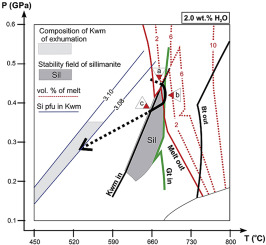当前位置:
X-MOL 学术
›
J. South Am. Earth Sci.
›
论文详情
Our official English website, www.x-mol.net, welcomes your feedback! (Note: you will need to create a separate account there.)
Paleoproterozoic P-T-d-t evolution of a gneiss with quartz-sillimanite nodules from the Azul ranges, Rio de la Plata craton, Argentina
Journal of South American Earth Sciences ( IF 1.8 ) Pub Date : 2020-03-01 , DOI: 10.1016/j.jsames.2019.102453 Franco Denis Bianchi , Juan Cruz Martínez , Melisa Angeletti , María Cristina Frisicale , Hans-Joachim Massonne , Jorge Anastasio Dristas
Journal of South American Earth Sciences ( IF 1.8 ) Pub Date : 2020-03-01 , DOI: 10.1016/j.jsames.2019.102453 Franco Denis Bianchi , Juan Cruz Martínez , Melisa Angeletti , María Cristina Frisicale , Hans-Joachim Massonne , Jorge Anastasio Dristas

|
Abstract The southernmost outcrops of the ~30 km long metamorphic belt of the Azul ranges in the Rio de la Plata craton were studied in detail with special emphasis on a gneiss with quartz-sillimanite nodules. Pressure (P) - temperature (T) and T-H2O pseudosections were calculated for such a gneiss and contoured with the PERPLE_X computer software package. Remnant oriented, K-white mica laths in K-feldspar of the gneiss matrix suggest an initial metamorphic P-T path at the onset of anatexis near ~660° at 0.43 GPa and water-saturation. Peak metamorphic conditions of ~680 °C and 0.40 GPa were reached excluding garnet growth. Back-reactions in the presence of a hydrous fluid and syntectonic coaxial deformational stress (D1) produces (1) the nodules by dealkalization of K-feldspar and (2) large, roughly oriented porphyroblasts of K-white mica after sillimanite at ~650 °C and 0.38 GPa. Homogeneous compositions of this mica (3.08–3.10 Si per formula unit) are the result of retrograde conditions in the range 450–580 °C at 0.15–0.35 GPa. A ductile deformation (D2) overprinted the exhumed rocks afterward. A set of 41 U-Th-Pb ages was determined with the electron microprobe from monazite in a leucocratic sillimanite-bearing vein, a quartz-sillimanite nodule, and the quartzofeldspathic matrix of the gneiss. Two age groups could be defined: (I) 2127 ± 10 (1σ) Ma and (II) 2039 ± 3 (1σ) Ma. Group II is assigned to the peak metamorphic event, whereas group I is related to the Encantadas accretionary orogeny, which provided the source material for the sedimentary protolith of the gneiss.
中文翻译:

阿根廷里约热内卢拉普拉塔克拉通 Azul 山脉带石英硅线石结核的片麻岩古元古代 PTdt 演化
摘要 对拉普拉塔河克拉通 Azul 山脉约 30 公里长变质带最南端的露头进行了详细研究,重点研究了具有石英-硅线石结核的片麻岩。压力 (P) - 温度 (T) 和 T-H2O 假截面是针对这种片麻岩计算的,并使用 PERPLE_X 计算机软件包绘制轮廓。片麻岩基质的 K 长石中残余取向的 K 白云母板条表明在 0.43 GPa 和水饱和度下接近 660° 附近的熔沸点开始时的初始变质 PT 路径。达到了~680 °C 和 0.40 GPa 的峰值变质条件,不包括石榴石生长。在含水流体和同构造同轴变形应力 (D1) 存在下的逆反应产生 (1) 钾长石脱碱产生的结核和 (2) 大的、在 ~650 °C 和 0.38 GPa 条件下,经过硅线石处理后的 K 白云母的大致定向的卟啉母细胞。这种云母的均匀成分(每配方单位 3.08–3.10 Si)是在 450–580 °C 和 0.15–0.35 GPa 条件下逆行的结果。韧性变形(D2)随后覆盖了挖掘出的岩石。一组 41 U-Th-Pb 年龄是用电子微探针从含白斑硅线石矿脉、石英-硅线石结核和片麻岩石英长石基质中的独居石中确定的。可以定义两个年龄组:(I) 2127 ± 10 (1σ) Ma 和 (II) 2039 ± 3 (1σ) Ma。第二组被指定为峰值变质事件,而第一组与 Encantadas 增生造山作用有关,它为片麻岩的沉积原岩提供了源材料。这种云母的均匀成分(每配方单位 3.08–3.10 Si)是在 450–580 °C 和 0.15–0.35 GPa 条件下逆行的结果。韧性变形(D2)随后覆盖了挖掘出的岩石。一组 41 U-Th-Pb 年龄是用电子微探针从含白斑硅线石矿脉、石英-硅线石结核和片麻岩石英长石基质中的独居石中确定的。可以定义两个年龄组:(I) 2127 ± 10 (1σ) Ma 和 (II) 2039 ± 3 (1σ) Ma。第二组被指定为峰值变质事件,而第一组与 Encantadas 增生造山作用有关,它为片麻岩的沉积原岩提供了源材料。这种云母的均匀成分(每配方单位 3.08–3.10 Si)是在 450–580 °C 和 0.15–0.35 GPa 条件下逆行的结果。韧性变形(D2)随后覆盖了挖掘出的岩石。一组 41 U-Th-Pb 年龄是用电子微探针从含白斑硅线石矿脉、石英-硅线石结核和片麻岩石英长石基质中的独居石中确定的。可以定义两个年龄组:(I) 2127 ± 10 (1σ) Ma 和 (II) 2039 ± 3 (1σ) Ma。第二组被指定为峰值变质事件,而第一组与 Encantadas 增生造山作用有关,它为片麻岩的沉积原岩提供了源材料。韧性变形(D2)随后覆盖了挖掘出的岩石。一组 41 U-Th-Pb 年龄是用电子微探针从含白斑硅线石矿脉、石英-硅线石结核和片麻岩石英长石基质中的独居石中确定的。可以定义两个年龄组:(I) 2127 ± 10 (1σ) Ma 和 (II) 2039 ± 3 (1σ) Ma。第二组被指定为峰值变质事件,而第一组与 Encantadas 增生造山作用有关,它为片麻岩的沉积原岩提供了源材料。韧性变形(D2)随后覆盖了挖掘出的岩石。一组 41 U-Th-Pb 年龄是用电子微探针从含白斑硅线石矿脉、石英-硅线石结核和片麻岩石英长石基质中的独居石中确定的。可以定义两个年龄组:(I) 2127 ± 10 (1σ) Ma 和 (II) 2039 ± 3 (1σ) Ma。第二组被指定为峰值变质事件,而第一组与 Encantadas 增生造山作用有关,它为片麻岩的沉积原岩提供了源材料。(I) 2127 ± 10 (1σ) Ma 和 (II) 2039 ± 3 (1σ) Ma。第二组被指定为峰值变质事件,而第一组与 Encantadas 增生造山作用有关,它为片麻岩的沉积原岩提供了源材料。(I) 2127 ± 10 (1σ) Ma 和 (II) 2039 ± 3 (1σ) Ma。第二组被指定为峰值变质事件,而第一组与 Encantadas 增生造山作用有关,它为片麻岩的沉积原岩提供了源材料。
更新日期:2020-03-01
中文翻译:

阿根廷里约热内卢拉普拉塔克拉通 Azul 山脉带石英硅线石结核的片麻岩古元古代 PTdt 演化
摘要 对拉普拉塔河克拉通 Azul 山脉约 30 公里长变质带最南端的露头进行了详细研究,重点研究了具有石英-硅线石结核的片麻岩。压力 (P) - 温度 (T) 和 T-H2O 假截面是针对这种片麻岩计算的,并使用 PERPLE_X 计算机软件包绘制轮廓。片麻岩基质的 K 长石中残余取向的 K 白云母板条表明在 0.43 GPa 和水饱和度下接近 660° 附近的熔沸点开始时的初始变质 PT 路径。达到了~680 °C 和 0.40 GPa 的峰值变质条件,不包括石榴石生长。在含水流体和同构造同轴变形应力 (D1) 存在下的逆反应产生 (1) 钾长石脱碱产生的结核和 (2) 大的、在 ~650 °C 和 0.38 GPa 条件下,经过硅线石处理后的 K 白云母的大致定向的卟啉母细胞。这种云母的均匀成分(每配方单位 3.08–3.10 Si)是在 450–580 °C 和 0.15–0.35 GPa 条件下逆行的结果。韧性变形(D2)随后覆盖了挖掘出的岩石。一组 41 U-Th-Pb 年龄是用电子微探针从含白斑硅线石矿脉、石英-硅线石结核和片麻岩石英长石基质中的独居石中确定的。可以定义两个年龄组:(I) 2127 ± 10 (1σ) Ma 和 (II) 2039 ± 3 (1σ) Ma。第二组被指定为峰值变质事件,而第一组与 Encantadas 增生造山作用有关,它为片麻岩的沉积原岩提供了源材料。这种云母的均匀成分(每配方单位 3.08–3.10 Si)是在 450–580 °C 和 0.15–0.35 GPa 条件下逆行的结果。韧性变形(D2)随后覆盖了挖掘出的岩石。一组 41 U-Th-Pb 年龄是用电子微探针从含白斑硅线石矿脉、石英-硅线石结核和片麻岩石英长石基质中的独居石中确定的。可以定义两个年龄组:(I) 2127 ± 10 (1σ) Ma 和 (II) 2039 ± 3 (1σ) Ma。第二组被指定为峰值变质事件,而第一组与 Encantadas 增生造山作用有关,它为片麻岩的沉积原岩提供了源材料。这种云母的均匀成分(每配方单位 3.08–3.10 Si)是在 450–580 °C 和 0.15–0.35 GPa 条件下逆行的结果。韧性变形(D2)随后覆盖了挖掘出的岩石。一组 41 U-Th-Pb 年龄是用电子微探针从含白斑硅线石矿脉、石英-硅线石结核和片麻岩石英长石基质中的独居石中确定的。可以定义两个年龄组:(I) 2127 ± 10 (1σ) Ma 和 (II) 2039 ± 3 (1σ) Ma。第二组被指定为峰值变质事件,而第一组与 Encantadas 增生造山作用有关,它为片麻岩的沉积原岩提供了源材料。韧性变形(D2)随后覆盖了挖掘出的岩石。一组 41 U-Th-Pb 年龄是用电子微探针从含白斑硅线石矿脉、石英-硅线石结核和片麻岩石英长石基质中的独居石中确定的。可以定义两个年龄组:(I) 2127 ± 10 (1σ) Ma 和 (II) 2039 ± 3 (1σ) Ma。第二组被指定为峰值变质事件,而第一组与 Encantadas 增生造山作用有关,它为片麻岩的沉积原岩提供了源材料。韧性变形(D2)随后覆盖了挖掘出的岩石。一组 41 U-Th-Pb 年龄是用电子微探针从含白斑硅线石矿脉、石英-硅线石结核和片麻岩石英长石基质中的独居石中确定的。可以定义两个年龄组:(I) 2127 ± 10 (1σ) Ma 和 (II) 2039 ± 3 (1σ) Ma。第二组被指定为峰值变质事件,而第一组与 Encantadas 增生造山作用有关,它为片麻岩的沉积原岩提供了源材料。(I) 2127 ± 10 (1σ) Ma 和 (II) 2039 ± 3 (1σ) Ma。第二组被指定为峰值变质事件,而第一组与 Encantadas 增生造山作用有关,它为片麻岩的沉积原岩提供了源材料。(I) 2127 ± 10 (1σ) Ma 和 (II) 2039 ± 3 (1σ) Ma。第二组被指定为峰值变质事件,而第一组与 Encantadas 增生造山作用有关,它为片麻岩的沉积原岩提供了源材料。



























 京公网安备 11010802027423号
京公网安备 11010802027423号